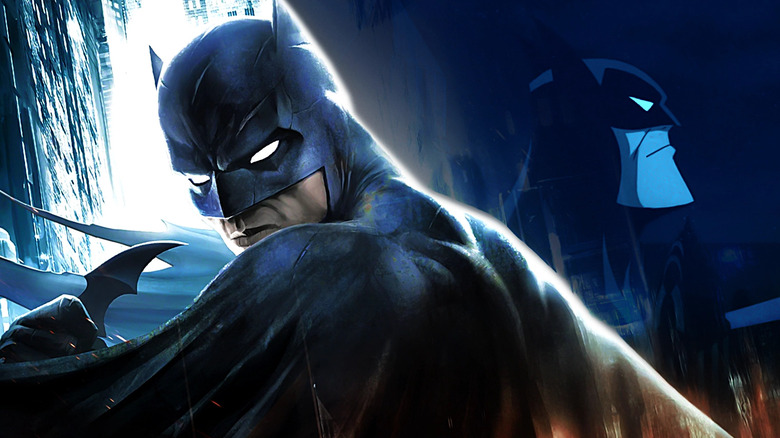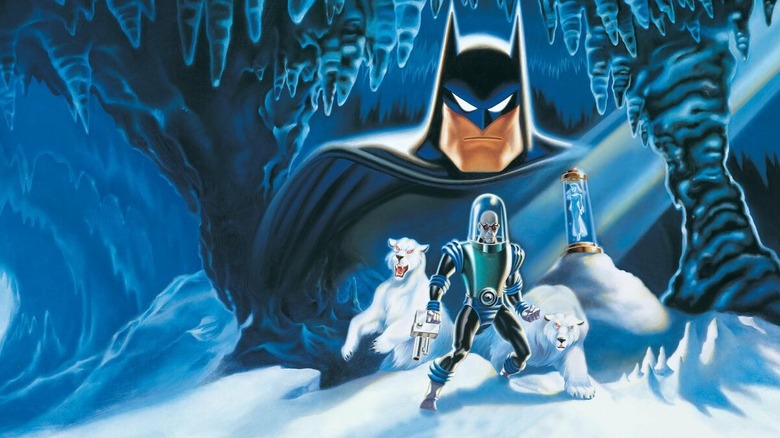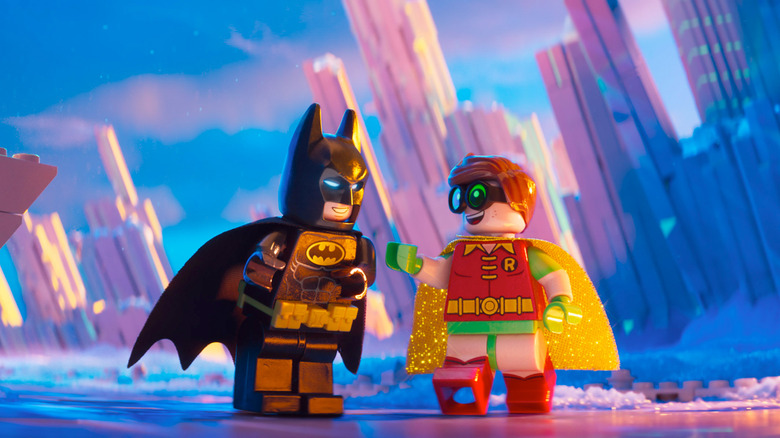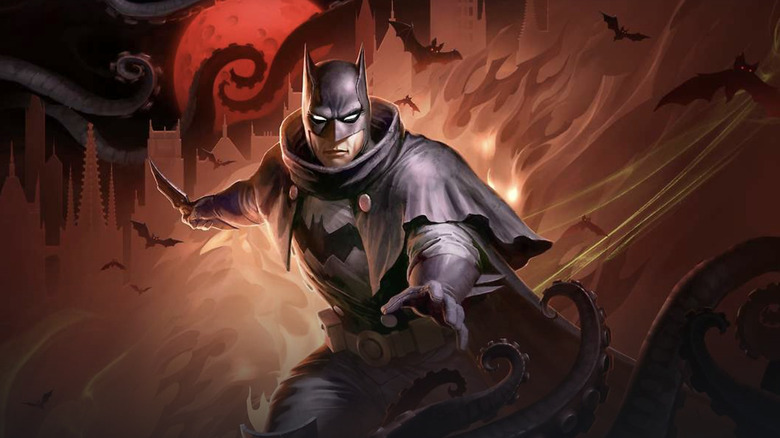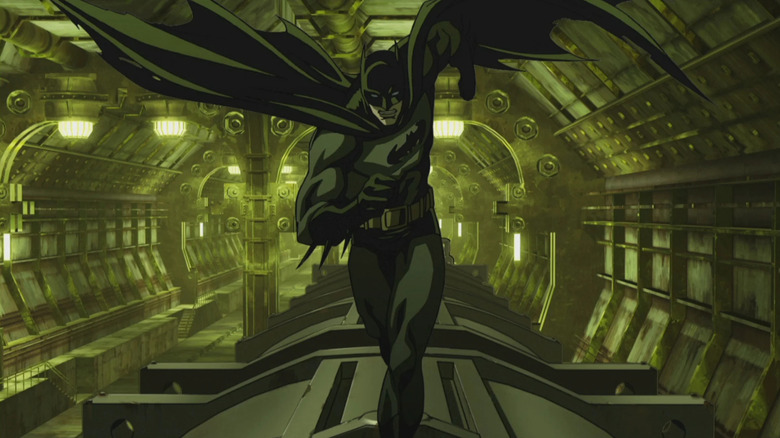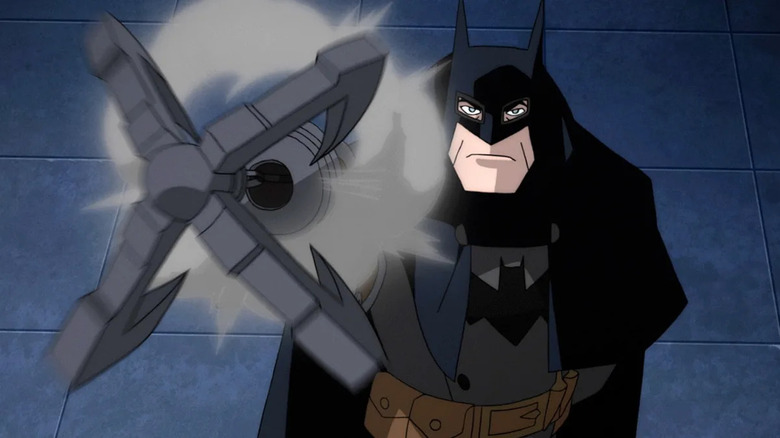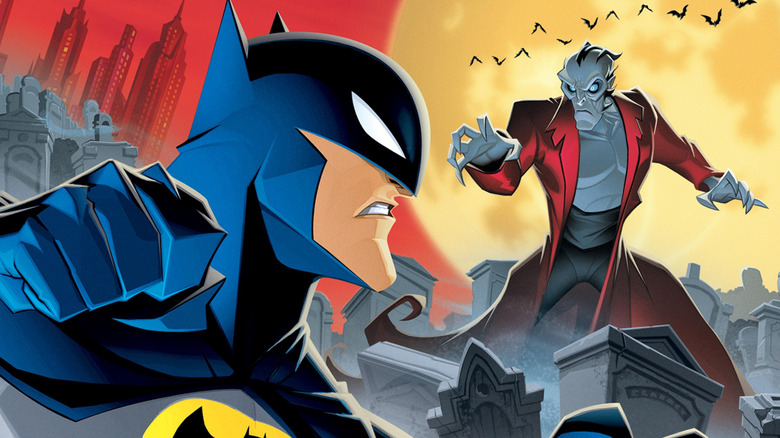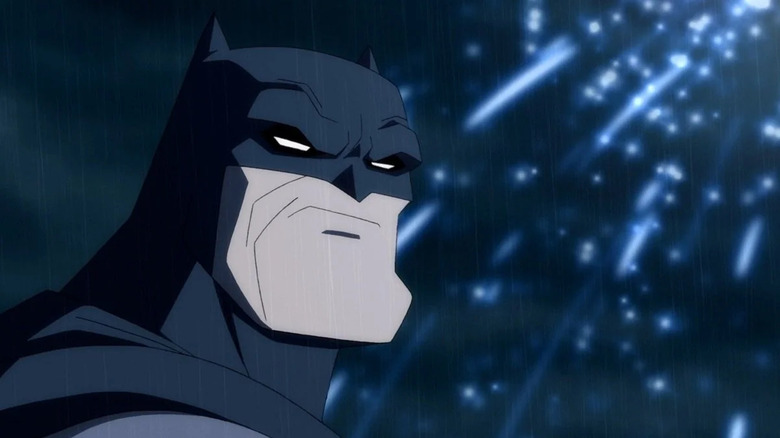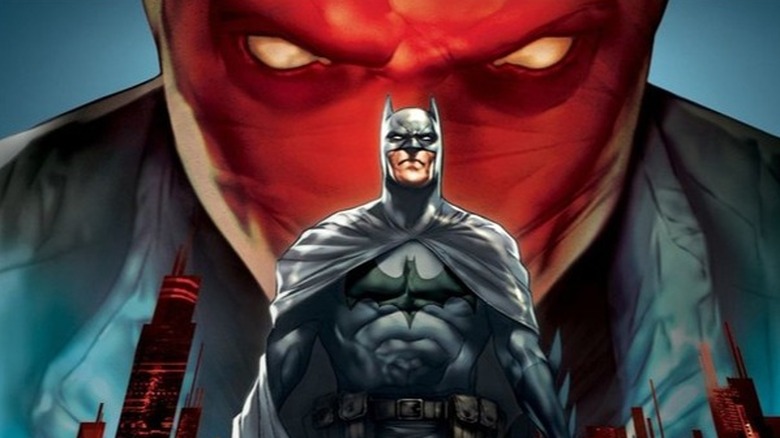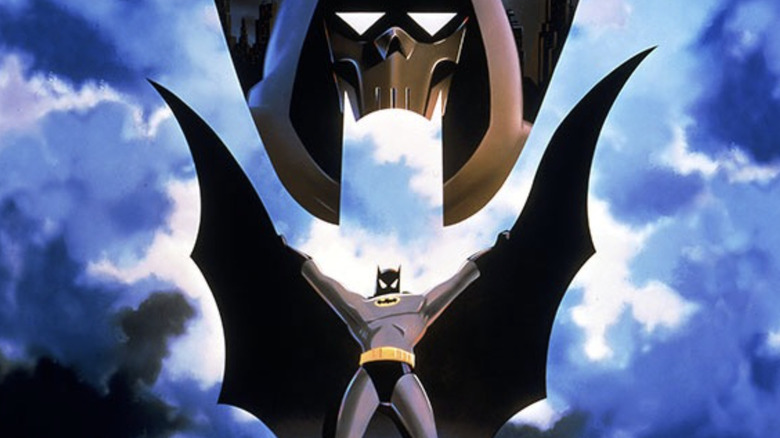The 10 Best Animated Batman Movies, Ranked
If you look at a lot of the best films in the superhero genre, a common denominator is Batman. The Caped Crusader's 80+ year legacy makes him one of the comic book heroes most open for interpretation. Different filmmakers have produced widely different, yet equally excellent, Batman movies. 1966's "Batman: The Movie" is a camp classic. "Batman Returns" is a gothic German Expressionist melodrama only Tim Burton could have made. Christopher Nolan's "The Dark Knight" and Matt Reeves' "The Batman" are both fantastic crime dramas with big ideas most superhero movies don't even reach for.
But it'd be a big mistake to leave animation out of this conversation. "Batman: The Animated Series" is generally considered the finest Batman adaptation ever, proof positive the Dark Knight can excel on film no matter the medium. There are also many more animated Batman movies than live-action ones at this point. Many of them directly adapt famous Batman comic stories, but others tell original ones too. So, which are the very best of the best (and do any of them reach the same heights as "The Dark Knight" or "The Batman")?
10. Batman & Mr. Freeze: SubZero
Harley Quinn is the most enduring legacy of "Batman: The Animated Series," but a close second has to be the show's reinvention of Mr. Freeze (once called Mr. Zero). The Emmy-winning "Heart of Ice" explained why the villain had such a cold, cold heart. Victor Fries doesn't just have an ice fetish, he was a scientist trying to save his terminally-ill wife Nora with cryogenics. A lab accident, sparked by his greedy boss Ferris Boyle, (seemingly) killed Nora and turned Fries into Freeze.
The show brought Mr. Freeze back for the episode "Deep Freeze," which revealed Nora was still alive in suspended animation. Freeze's goal became curing her, which carried over into part three of his story: the feature-length "Batman & Mr. Freeze: SubZero." It's basically an extended episode of "Batman: The Animated Series," but that's a high compliment in my book! I've never loved how the sequel series "New Batman Adventures" moved away from the Fleischer Studios-look of "The Animated Series," so another taste of that art style is worth savoring.
Released in 1998, the movie was made as a tie-in with "Batman & Robin," which featured Arnold Schwarzenegger as Freeze. (This is a recursive influence, as the "Batman & Robin" Freeze was modeled on the animated one.) While "Batman & Robin" was dismissed as a kitschy mess, "SubZero" reaffirmed the dramatic storytelling people loved about "Batman: The Animated Series." It's not the most ambitious Batman film, but it's tight and effective entertainment.
9. The Lego Batman Movie
Will Arnett's Lego Batman was a breakout supporting character in 2014's "The Lego Movie." (Hogging the spotlight in a story not about him is a very Batman move.) After that, a spin-off was inevitable. Enter 2017's "The Lego Batman Movie," directed by Chris McKay. The movie is very much counter-programming to the live-action Batman films of the 2000s. Yet, it also has a surprising overlap with the preceding (and incredibly dark) "Batman V Superman: Dawn of Justice." That film was about a Batman who'd lost his way and gained tunnel vision into the darkness. "The Lego Batman Movie" is similarly about Batman rediscovering lightness in his life.
Lego Bruce Wayne is a complete workaholic with no purpose beyond battling bad guys like the Joker (Zach Galifianakis) in "The Lego Batman Movie." Then, the orphan Dick Grayson/Robin (Michael Cera) steps into his life, while Bruce also develops feelings for new police commissioner Barbara Gordon (Rosario Dawson). Even (or because) it's a comedy first and foremost, "The Lego Batman Movie" is the only Batman movie to mix it up and depict Bruce Wayne as the family man he can often be.
8. Batman: The Doom That Came To Gotham
Superhero stories are about as far away from cosmic horror as you can get. One is about inhuman, unknowable, and unbeatable ancient horrors, while the other is about exceptional people who always save the day. Yet, "Batman: The Doom That Came to Gotham" somehow merges these two disparate tones.
"The Doom That Came to Gotham" was directed by Christopher Berkeley & Sam Liu, and adapted from a 2000 comic by Mike Mignola, Richard Pace, and Troy Nixey. Set in the 1920s, the film depicts a Bruce Wayne who becomes the Batman not to fight mere criminals but a cult out to unleash a horrible monster and, in turn, doomsday upon Gotham. Mignola, the creator of Hellboy, spins a yarn similar to that for Batman: a pulp adventurer facing down Lovecraftian creatures. Like Hellboy himself, Bruce Wayne can't stop his destiny, and learns the only way to save a new world may be the destruction of the old.
The movie updates the usuals looks of Batman and co. to fit the time period and story. Batman's (an impressive performance from David Giuntoli) costume mixes a familiar cowl with a collar and a shoulder-padded cape. His usual villains go from eccentrics in silly costumes to genuine monsters: Poison Ivy is a plant creature and spawn of the monstrous Iog-Sotha, Mr. Freeze as an eyeless walking corpse in an ancient divers suit, and Killer Croc resembles an upright velociraptor. It's not just the character designs that are there for horror; the foreboding atmosphere and sense of increasing, well, doom in every scene make this one of the most unnerving Batman pictures.
7. Batman: Gotham Knight
"Batman: Gotham Knight" stands as one of the more unique Batman films. Released in 2008, it's ostensibly in-canon with the Christopher Nolan Batman films and takes place between "Batman Begins" and "The Dark Knight" (although Kevin Conroy voices Batman, not Christian Bale).
It's also an anthology: "Gotham Knight" is made up of six shorts stitched together, each with a different writer and a different art style. "Crossfire," animated by Production I.G. (the studio behind "Ghost in the Shell"), looks the most typically anime-like, for instance. The different shorts lead into each other, but each stands on its own.
The first segment (written by Josh Olson, animated by Studio 4°C) is "Have I Got A Story For You," which is about Gotham kids swapping stories involving Batman. It's basically a remake of the "New Batman Adventures" episode "Legends of the Dark Knight," but it sets up how the movie itself is telling widely different stories about Batman.
The stand-out segment is "In Darkness Dwells," which has Batman trudging through Gotham's sewers to rescue a Cardinal kidnapped by the Scarecrow. (David S. Goyer wrote this segment, so it has the best argument to actually being canon to the "Dark Knight" trilogy.) Animated by Madhouse, "In Darkness Dwells" has some of the most stylized animation and character designs in the film. Yet, it's also the segment with the most visual fidelity to the Nolan movies, from Batman's costume to the appearance of Gotham City itself. Granted, as "Gotham Knight" sets out to prove, there's more than one way to tell a Batman story.
6. Batman: Gotham by Gaslight
DC Comics' "Elseworlds" stories take familiar heroes and puts them in unfamiliar, non-canon settings. One of the earliest and most famous ones is Brian Augustyn and Mike Mignola's 1989 comic book "Gotham by Gaslight," which was made into a film almost 30 years later.
Directed by Sam Liu, "Batman: Gotham by Gaslight" imagines if Bruce Wayne had lived and become Batman in the late 19th century. Naturally, the World's Greatest Detective has to solve the era's foremost unsolved mystery: the truth about Jack the Ripper, who has begun killing in Gotham.
This Gotham, lit by gaslight and lined with cobblestone roads, is unrecognizable. There are no skyscrapers for Batman to perch on, but he can still disappear into the foggy shadows. The movie uses Mignola's Batman redesign from the comic (which adds a period appropriate collar to Batman's cowl), but otherwise does not replicate his art style. Not to worry, because "Gotham By Gaslight" instead uses producer Bruce Timm's distinctive style. It's not as dark or detailed as Mignola's art in the "Gotham by Gaslight" comic, but it's a proven look for Batman animation.
Among other changes, the movie stretches out the story. Selina Kyle (Jennifer Carpenter), reimagined as an actor and cabaret dancer, is added as Batman's partner in catching the Ripper. The movie also lets Selina demonstrate her singing skills with a performance of "Can You Tame Wild Wimmen?" (which the comic couldn't do even if it wanted to), with Grey DeLisle replacing Carpenter as Selina's singing voice. 19th century Batman is a great elevator pitch, and "Gotham by Gaslight" will make you want more than just this single taste of it.
5. The Batman vs. Dracula
2004's "The Batman" is a fun and sometimes underrated series that wasn't afraid to take big swings. You can see that with its spin-off film, one that lives up to exactly what its audacious title promises: "The Batman vs. Dracula."
While hunting for some lost treasure in a Gotham graveyard, the Penguin (Tom Kenny) accidentally unearths a long-forgotten tomb — the lord of the vampires'. Cobblepot becomes Renfield as Dracula (Peter Stormare) begins terrorizing Gotham at night, intending to make it into a city of the dead. All that stands in his way, of course, is Batman (Rino Romano). But to paraphrase a different movie, Batman has only adopted the darkness — Dracula is the prince of it, with speed and strength that outmatches even the Caped Crusader's refined battle skills. Bruce Wayne may dress like a bat, but Dracula can become one. What the Batman does have, though, is strength of will.
"The Batman vs Dracula" avoids feeling like just an extended episode of the show because it raises the stakes and scope. The movie is three times as long as a typical "The Batman" adventure because Dracula is just that big a threat. He could plunge Gotham into an apocalypse, not just a crime wave. The cartoon's usual score (composed by Thomas Chase) is reused, but the smooth guitar riffs for Batman contrast with an eerie violin theme for Dracula, signaling how out of place this ancient evil is.
Unlike the show, the movie was also rated TV-PG. It can actually show blood onscreen, and the film gets away with violence and terror the show never could (see: vampire Joker). "The Batman vs Dracula" is still an appropriate movie for kids, but it pushes the envelope just enough that it will actually feel intense and scary to them.
4. Batman: The Dark Knight Returns
Most of the direct-to-DVD DC animated films never exceed 75 minutes. Some, like "Batman: Hush," have had to cut down their source material's plot to get to that runtime. 2012's "The Dark Knight Returns" was instead made and released as a two-part movie. Frank Miller's original comic book has four issues, each one with a distinct mood, arc, and villain. The 140-minute total runtime gives every section of the story room to breathe.
Instead of adjusting the art to the house style, the movie's characters are drawn as beefy as Miller originally did. The film by design can't replicate some of the comic's flourishes, like Miller's 16-panel grids (showing the effect of mass media, experiencing talking heads all at once) or Lynn Varley's painterly coloring. But where it loses some detail, the animated "Dark Knight Returns" adds others. Leaning on the 1980s setting, Christopher Drake's score sometimes uses John Carpenter style synth music. This gang-afflicted Gotham City is barely removed from the setting of "Assault on Precinct 13" or "Escape from New York."
Peter Weller and Michael Emerson are both perfectly cast as middle-aged versions of Batman and the Joker, too. The film ditches Batman's inner monologue, but since that was so important to the book, the script cleverly reworks some of Miller's lines from narration into dialogue.
Batman lamenting "all the people [he's] murdered ... by letting [The Joker] live" is turned from some inner flagellation to something Batman says to the Joker's face. That leads to this memorable exchange: "I never kept count." "I did!" "I know — and I love you for it!" Batman and Superman's climactic clash goes from a standing-in-place slugfest to something more dynamic and acrobatic, another perfect example of how "The Dark Knight Returns" knows where to be exactly like the source material and where to adjust it.
3. Batman: Under The Red Hood
In Jim Starlin and Jim Aparo's 1988 "Batman: A Death in the Family," the Joker murders the second Robin, Jason Todd. In 2005, writer Judd Winick and artist Doug Mahnke brought Jason back to life as the Red Hood, an alias once used by the Joker. Jason had taken his murderer's old nom de guerre to call him out because he was truly red with anger at not only Joker but also Batman (for not having already avenged him).
Winick got to tell the story a second time, and work out the kinks, in the 2010 film "Batman: Under the Red Hood." (Winick wrote the script, Jay Olivia directed it.) The movie is generally considered the definitive version of the story. It's much more focused and self-contained than the comic, with strong action animation and voice acting. Bruce Greenwood was so good as Batman that he's returned to the role several times since then, while John "Bender Bending Rodrigeuz" DiMaggio is more chilling than you could ever imagine as the Joker.
It's the movie's climax that makes it one of the greats. Jason (Jensen Ackles) captures the Joker, lures Batman to an abandoned apartment, and demands Bruce finally put the world out of its misery and kill the Joker. The genuine hatred and pain in Ackles' voice, night and day from his flippancy as Red Hood, makes the scene riveting. ("Pathetic pile of evil death-worshipping garbage" is one of the best descriptions of the Joker ever, too.)
Bruce admits he wants to kill his nemesis, badly, but he holds back because he's afraid he'd never stop. He'd become what Jason has, a murderous vigilante who's not so different from a gangster, but remember Jason only went down that path because Batman brought a boy into a war. Jason may not be dead, but Batman doesn't absolve himself, nor does the movie. It closes on a flashback to Jason's first day as Robin, "the best day of his life," the perfect last stitch for a full-circle tragedy.
2. Batman Beyond: Return of the Joker
"Batman: The Animated Series" never got a climactic series finale, either during its original run or when it returned as "New Batman Adventures." Sequel series "Batman Beyond" jumped ahead 40 years, when a now elderly Bruce Wayne (Kevin Conroy) was training Gotham teenager Terry McGinnis (Will Friedle) to be the new Batman.
But even as "Batman Beyond" forged its own identity, not all the faces of the past could stay buried. Enter the spin-off movie "Return of the Joker." As promised, the original Batman's most depraved adversary (the always excellent Mark Hamill) returns from the grave, somehow looking no older than when we last saw him in "The Animated Series." The Joker is one of the most recognizable villains in pop culture, yet he's an enigma with no true name or backstory. In "Return of the Joker," he's more mysterious than ever, and Terry is forced to step up as a detective to find out the truth behind his resurgence.
"Batman Beyond: Return of the Joker" is mostly remembered for an extended flashback sequence showing the original Batman and Joker's final clash. Taking cues from "A Death in the Family," the Joker kidnaps and tortures Robin (Tim Drake) as his sickest joke on Batman yet — one that ends with a killer punchline. That was the only way Batman and the Joker's rivalry could ever end, even if a serialized cartoon like "Batman: The Animated Series" never reached that point.
1. Batman: Mask of the Phantasm
The second best animated "Batman" film may be about the Dark Knight's future, but the very best one is about his past. Produced by the team behind "Batman: The Animated Series" and even given a theatrical release, "Mask of the Phantasm" is a mostly original story (but with shades of "Batman: Year One," "Year Two," and "Strange Apparitions"). A grim reaper themed vigilante, the Phantasm (Stacy Keach), begins picking off Gotham City gangsters. Most assume that Batman (Kevin Conroy) has finally turned lethal, which means he has to unmask the Phantasm to clear his own name.
Interspersed with the present story are flashbacks to before Bruce Wayne became Batman. "Batman: The Animated Series" begins in media res, no origin story required, but this one looks back because it has something new to add to the myth. Bruce fell for lonely rich girl Andrea Romano (Dana Delany), and was even considering abandoning his crime-fighting plans to be with her. Conroy's finest moment as Batman is in "Mask of the Phantasm" — pleading before his parents' graves, he asks for forgiveness in not keeping the promise he made in that same spot. But then Andrea walks out of his life, and all that remains for Bruce is Batman.
Lushly animated, scored with the power of an opera, and emotionally resonant, there's not much more to say about "Mask of the Phantasm" besides what a triumph it is.
